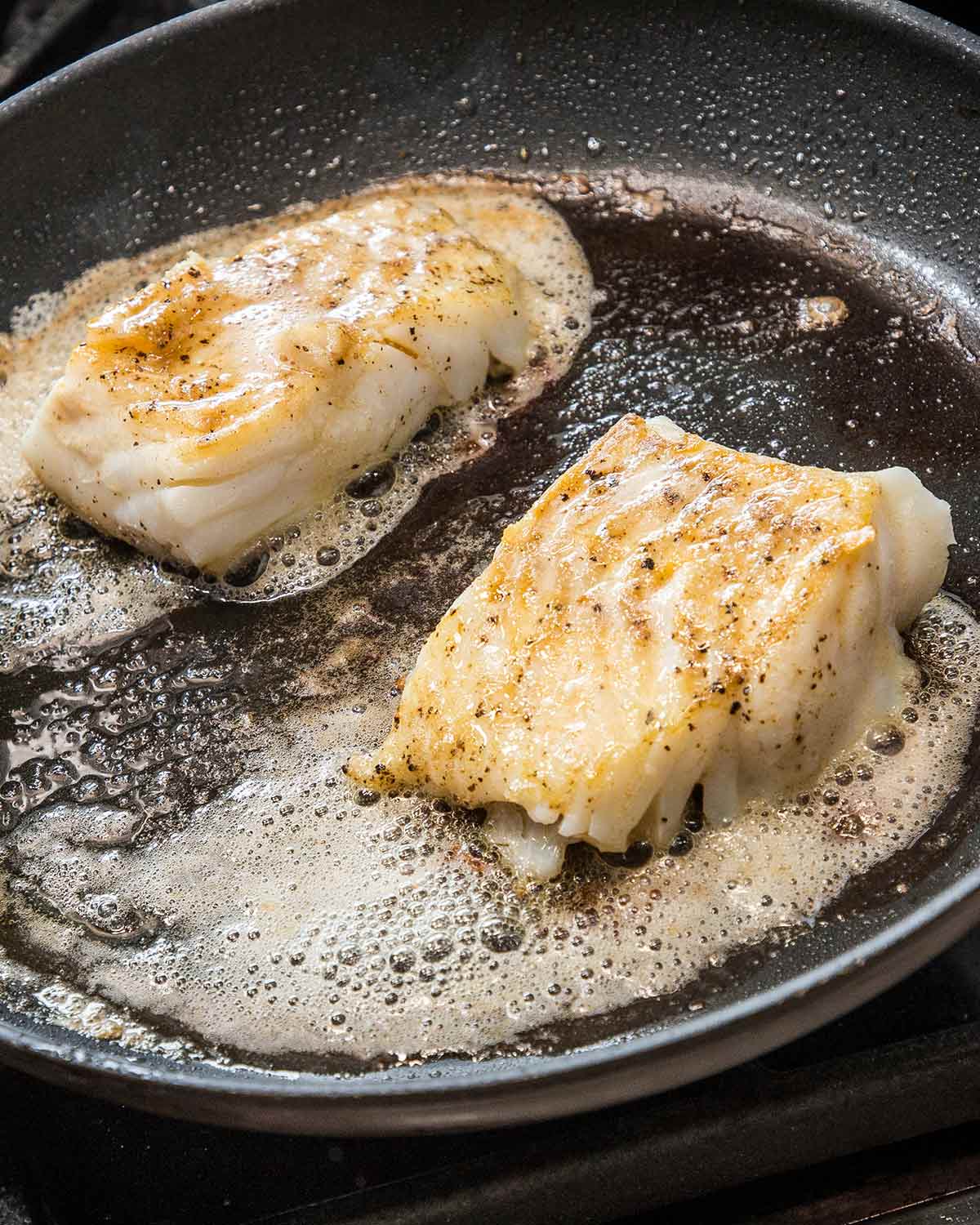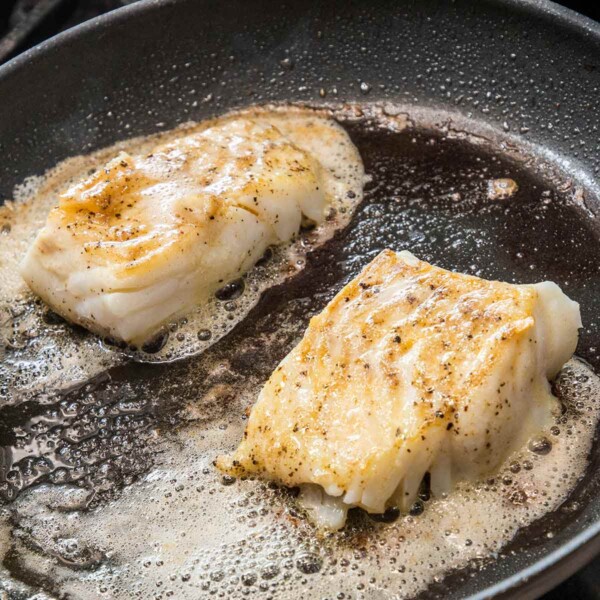
Butter basting sounds like music to the ears: The technique involves repeatedly spooning sizzling butter over food as it cooks. The butter bath, which is also a classic method for cooking big beef steaks, is great for mild, lean, flaky fish. The hot butter helps cook the top of the fillet as the skillet heats the bottom, allowing you to flip the delicate fish only once and early in the cooking process before the flesh has become too fragile. Throughout the process, the butter browns and coats the mild fish in savory flavor, adding richness. We add thyme sprigs and crushed garlic cloves to the pan, which infuse the butter as it heats and makes for an aromatic dish. Lemon wedges are a must; the brightness of the lemon juice cuts through the butter’s richness.–America’s Test Kitchen
*What kind of fish can I use?
Any firm, flaky white fish works wonders here as long as it’s approximately 1 inch thick, whether fresh or frozen, thawed, and patted completely dry. That includes cod, halibut, black sea bass, haddock, or hake.

Butter Basted Fish With Garlic and Thyme
Ingredients
- Two (6 to 8 ounce) skinless firm white fish fillets*, such as cod, halibut, black sea bass, haddock, or hake, 1 inch (25 mm) thick
- 1/2 teaspoon kosher salt
- 1/8 teaspoon freshly ground black pepper
- 1 tablespoon mild vegetable oil
- 3 tablespoons (1 1/2 oz) unsalted butter, cut into 1/2-inch (12-mm) cubes
- 2 garlic cloves, crushed and peeled
- 4 sprigs fresh thyme
- Lemon wedges, for serving
Instructions
- Pat all sides of fillets dry with paper towels. Sprinkle on all sides with salt and pepper.
- In a 12-inch (30-cm) nonstick skillet over medium-high heat, warm oil until hot but not smoking.
- Reduce heat to medium and place fish skinned side down in the skillet. Using a fish spatula, gently press on each fillet for 5 seconds to ensure good contact with a skillet. Cook the fish, without moving it, until the underside is light golden brown, 4 to 5 minutes.
- Using 2 spatulas, gently flip fillets and cook for 1 minute more.
- Scatter the butter around the fish. When the butter is melted, tilt skillet slightly toward you so that butter pools at front of skillet. Using large spoon, scoop up melted butter and pour over the fish repeatedly for 15 seconds. Place skillet flat on burner and continue to cook 30 seconds more. Tilt skillet and baste for 15 seconds.
- Place the skillet flat on burner and take temperature of thickest part of each fillet. Continue to alternate basting and cooking until fillets reach 130°F (54°C), about 2 minutes more.
- Add garlic and thyme sprigs to skillet at the 12 o’clock position (butter may spatter). When spattering has subsided, continue basting and cooking until fillets reach 135°F (57°C) at the thickest point.
- Transfer fish fillets to individual plates. Discard garlic. Top each fillet with thyme sprigs, drizzle with the butter in the skillet, and serve with lemon wedges.

Explore More with AI
Nutrition
Nutrition information is automatically calculated, so should only be used as an approximation.
Recipe Testers’ Reviews
Versatility and simplicity are the hallmarks of this cooking technique. And once you’ve mastered the method, you can cook anything from scallops to pork chops. Change out the herbs to change up the flavor. Add a squeeze of orange or lime in place of lemon, depending on your protein. The possibilities of deliciousness are endless.
My cod fillets were 6-oz each. They took 4 minutes on the first side, and then another 4 on the second with three bastes. I turned off the heat and let them rest an additional 4 minutes because they were really thick. This makes 2 servings—we had the butter basted fish with garlic and thyme with orzo with lemon and capers on the side.
This is a great recipe for a weeknight. From start to finish it takes fewer than 15 minutes for this delicious cod dish. This is a simple preparation with a big reward. The combination of butter, garlic, and thyme are delicious on an otherwise bland fish. I always think of cod as a fish waiting to happen. It needs help and simple as this may be, it is just the help it needs to make it very tasty. The recipe calls for the cod to cook to 135°F. This is the perfect temperature where the fish is done all the way through, but still has plenty of moisture in it. I served the butter basted fish with garlic and thyme with a large salad.
What an easy and elegant dinner! Butter-basting is something I had only seen done on TV, so it was interesting to actually do it myself. It was a breeze, and the internal temperatures were a good guide as to when to take the fish off the heat. The cooking time was spot-on: 5 minutes on the first side and almost 4 minutes on the second side. The finished butter basted fish with garlic and thyme was plump and succulent, and it was absolutely lovely with the butter, which had become nuttier and richer as it cooked. I served the fish with steamed fingerling potatoes and broccoli, both of which paired well with the extra butter sauce on the plate.
I heated the oil to near smoking stage. Once I put the dry fillets in the pan, they sizzled immediately. I tried turning them at 4 and 5 minutes. Both times, the fish was stuck (I used a non-stick pan). I didn’t want to go past 5 minutes because I felt the fish would over cook during the basting process. Unfortunately, when I did flip it, I lost the crust in the bottom of the pan.
Once flipped, I added the butter and once melted, I started basting the fish. I basted 2 times for 15 seconds prior to adding 2 cloves of garlic and the thyme. My garlic did not spatter at all. I continued to baste 15 seconds off the burner for an additional 6 minutes. I did not keep basting for 8-10 minutes as the temperature on the fish would have been over cooked.
This recipe made 2 servings. I did cut off the thinner pieces of cod because I was concerned that the fish would cook unevenly. I tasted the butter basted fish with garlic and thyme and it definitely needed lemon when finished. I would suggest adding it to the butter sauce while the pan is still hot and prior to drizzling the sauce over the fish.
I eat a lot of fish so I’m definitely adding this to my regular rotation.
The last time I cooked pollock on the stove, it fell apart so quickly I ended up dumping an unappetizing-looking pile of fish flakes onto my plate. This recipe really does help maintain the structural integrity of a delicate white fish fillet so you can retain some semblance of an aesthetically pleasing dish presentation and salvage your reputation as a cook.
I ended up just ignoring my timer. You’ll need to adjust cooking time a bit anyway based on your own pan, stove, and thickness of the fillet. Since you are pretty much “tending” to your fillet the entire time while basting it with butter, you can really gauge when it’s done without relying on a clock. The thyme smells absolutely intoxicating while you lean over the pan to spoon the sizzling butter. Please note the results are almost too buttery…almost.
To balance it out don’t forget to serve with plenty of lemon wedges, and perhaps a bright fresh green salad and a glass of sauvignon blanc. Did this recipe blow me away? Well… not exactly. Is this a tasty, easy, and reliable weekday dinner? Absolutely!















I tried out the recipe tonight for dinner and it was yummy! My wife loved it as well! The recipe was simple to follow and easy to execute. This will definitely be added to our dinner rotation. Thanks for sharing!
You’re welcome, Jonathan. It looks like you and your wife had a lovely meal!